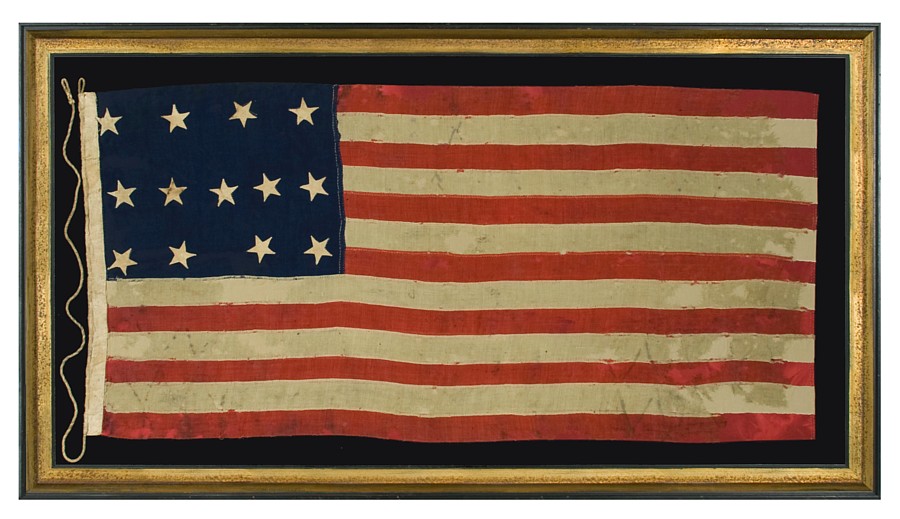
| |
13 STARS IN A 4-5-4 CONFIGURATION, ENTIRELY HAND-SEWN, PROBABLY A U.S. NAVY SMALL BOAT ENSIGN IN A GREAT SIZE, WITH GREAT GRAPHIC QUALITIES, MADE SOMETIME BETWEEN 1850 AND THE OPENING YEARS OF THE CIVIL WAR (1861-1863) |
|
| Available: |
Sold |
| Frame Size (H x L): |
44.5" x 82" |
| Flag Size (H x L): |
33" x 70" |
|
| Description....: |
|
13 STARS IN A 4-5-4 CONFIGURATION, ENTIRELY HAND-SEWN, PROBABLY A U.S. NAVY SMALL BOAT ENSIGN IN A GREAT SIZE, WITH GREAT GRAPHIC QUALITIES, MADE SOMETIME BETWEEN 1850 AND THE OPENING YEARS OF THE CIVIL WAR (1861-1863):
Entirely hand-sewn, 13 star American national flag. This is a U.S. Navy small boat ensign, made sometime between 1850 and the opening years of the Civil War (1861-1863), probably the latter, since production increased with the need driven by war. It could have been at the stern, from a gaff, or from the yard-arm on a larger craft, or on a small boat that carried sailors back and forth to shore.
The 4-5-4 row configuration is both scarcer and more appealing than rows of stars in counts of 3-2-3-2-3, and is generally seen on flags made during the Civil War period and prior. For some reason the 4-5-4 pattern was not popular during the celebration of our nation's 100-year anniversary in 1876 or thereafter, so it is both desired and more interesting than some other 13 star designs. It is sometimes seen in the 1890's on small 13 star flags made for use on private yachts, but these are scarce. Most private yacht flags carried different designs.
Note in particular the way in which the stars were placed on the navy blue canton, in haphazard rows, with uneven spacing, and facing in random positions on their vertical axis. In addition to the elongated proportions of the flag, which were typical of those of maritime use, the result has great folk quality and resulting visual interest.
The small scale of the flag adds considerably to its appeal. Today in the 21st century, a flag of this size might even be considered to be large. Prior to the 1890's however, this flag is extremely small when compared to its counterparts with sewn construction. Printed parade flags (sometimes called hand-wavers) were generally three feet long or smaller, but flags with sewn construction were generally between 8 and 20 feet in length. This is because flags needed to be seen from a distance to be effective in their purpose as signals, while today their use is more often decorative and for the general display of patriotism. During the 19th century, however, even those flags made for decorative purpose were often large by today's standards, so the average 19th century sewn flag can be cumbersome to frame and display in an indoor setting. This is why most collectors covet unusually small examples, like this one.
13 star flags have been used throughout our Nation's history for a variety of purposes. The U.S. Navy used the 13 star count on small boats, not only in the 18th century, but throughout much or all of the 19th century, particularly the second half. The reason for the use of this star count for such a long time is because ship captains were paranoid about recognizability of the flag on the open seas. On small flags in particular, viewed through a spyglass at a distance, the ability discern individual stars was a concern. Keeping the count at 13 maintained better visibility and consistency. The practice theoretically ended in 1916 following an executive order from then-President Woodrow Wilson, though old military traditions die hard and according to at least one expert, Wilson's order did not completely dispel the presence of 13 star flags on U.S. Navy craft.
Some private ships flew 13 star flags during the same period as the Navy, and the use of yachting ensigns with a wreath of 13 stars surrounding an anchor, which began in 1848, still persists today. Among other uses, 13 star flags were carried by soldiers during the Mexican and Civil Wars and displayed at various patriotic events, including Lafayette's final visit to the U.S. in 1825-26, the celebration of the Nation's centennial of independence in 1876, and the sesquicentennial in 1926.
Mounting: The flag has been hand-stitched to 100% cotton twill, both for support and for masking purposes. Fabric of similar coloration was placed behind the white stripes, also for masking purposes. The flag was then hand-stitched to a background of 100% cotton, black in color. The background fabric was washed to remove excess dye. An acid-free agent was added to the wash to further set the dye, and the fabric was heat-treated for the same purpose. The mount was then placed in a substantial, convex-profile, hand-gilded and distressed Italian molding. The front is u.v. protective acrylic.
Condition: Then flag has many losses. There are also some cross-hatch patterned stains. Fabric of similar coloration was used behind it to ghost out the missing fabric. Many of my clients prefer early flags to show their age and history of use. |
|
|
|
| Collector Level: |
Advanced Collectors and the Person with Everything |
|
| Flag Type: |
Sewn flag |
|
| Star Count: |
13 |
|
| Earliest Date of Origin: |
1850 |
|
| Latest Date of Origin: |
1863 |
|
| State/Affiliation: |
13 Original Colonies |
|
| War Association: |
1861-1865 Civil War |
|
| Price: |
SOLD |
|
| |
Views: 2990 |
|
|
|

